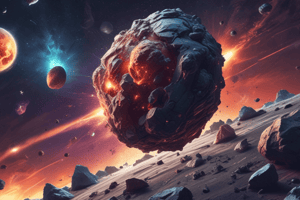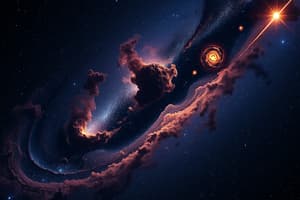Podcast
Questions and Answers
What celestial model places Earth at the center of the universe?
What celestial model places Earth at the center of the universe?
- Heliocentric Model
- Planetary Model
- Barycentric Model
- Geocentric Model (correct)
Galileo's observations supported the geocentric model of the universe.
Galileo's observations supported the geocentric model of the universe.
False (B)
Who proposed the heliocentric model?
Who proposed the heliocentric model?
Copernicus
1 AU is approximately equal to _____ meters.
1 AU is approximately equal to _____ meters.
Match the following terms with their definitions:
Match the following terms with their definitions:
What is primarily composed of gases in the outer solar system?
What is primarily composed of gases in the outer solar system?
All comets have a smooth and featureless surface.
All comets have a smooth and featureless surface.
What do we call the bright streak of light caused by meteoroids burning up in Earth's atmosphere?
What do we call the bright streak of light caused by meteoroids burning up in Earth's atmosphere?
The main source of energy for the solar system is the ______.
The main source of energy for the solar system is the ______.
Match the following celestial objects with their characteristics:
Match the following celestial objects with their characteristics:
What is created when solar flares occur?
What is created when solar flares occur?
Dwarf planets satisfy all conditions for planets except for having greater mass than anything that crosses their orbit.
Dwarf planets satisfy all conditions for planets except for having greater mass than anything that crosses their orbit.
What term is used for the clouds of gas surrounding a comet as it approaches the sun?
What term is used for the clouds of gas surrounding a comet as it approaches the sun?
What phenomenon occurs when the northern hemisphere is tilted towards the sun?
What phenomenon occurs when the northern hemisphere is tilted towards the sun?
Solar winds can damage electronics like satellites.
Solar winds can damage electronics like satellites.
What is the term for the motion of Earth around the sun?
What is the term for the motion of Earth around the sun?
The _____ is the path taken by the Sun across the sky over the course of the year.
The _____ is the path taken by the Sun across the sky over the course of the year.
Which star does Earth's axis currently point towards?
Which star does Earth's axis currently point towards?
Auroras are created by the collision of solar wind ions with Earth's atmosphere.
Auroras are created by the collision of solar wind ions with Earth's atmosphere.
How long does it take for Earth's axis to complete its precession cycle?
How long does it take for Earth's axis to complete its precession cycle?
Flashcards
Heliocentric Model
Heliocentric Model
A model where the Sun is at the center of the universe, with Earth and other planets orbiting around it.
Parallax
Parallax
The apparent change in position of an object when viewed from two different locations.
Hertzsprung-Russell Diagram
Hertzsprung-Russell Diagram
A diagram used to classify stars based on their brightness (luminosity) and temperature.
Cosmic Microwave Background Radiation
Cosmic Microwave Background Radiation
Signup and view all the flashcards
Nucleosynthesis
Nucleosynthesis
Signup and view all the flashcards
Asteroids
Asteroids
Signup and view all the flashcards
Shooting Star
Shooting Star
Signup and view all the flashcards
Solar Winds
Solar Winds
Signup and view all the flashcards
Meteorite
Meteorite
Signup and view all the flashcards
Comets
Comets
Signup and view all the flashcards
Solar Weather
Solar Weather
Signup and view all the flashcards
The Sun
The Sun
Signup and view all the flashcards
Seasons
Seasons
Signup and view all the flashcards
Sunspots
Sunspots
Signup and view all the flashcards
Revolution
Revolution
Signup and view all the flashcards
Solar Flares
Solar Flares
Signup and view all the flashcards
Rotation
Rotation
Signup and view all the flashcards
Celestial Sphere
Celestial Sphere
Signup and view all the flashcards
Scientific Notation
Scientific Notation
Signup and view all the flashcards
Ecliptic
Ecliptic
Signup and view all the flashcards
Constellations
Constellations
Signup and view all the flashcards
Study Notes
Asteroids, Comets, Meteors
- Asteroids are small, rocky objects, mostly located in the asteroid belt between Mars and Jupiter.
- Meteoroids are pieces of metal or rock in the solar system, smaller than asteroids.
- Meteors are meteoroids that enter Earth's atmosphere. Friction causes them to burn up, creating a bright streak of light, called a shooting star.
- Meteorites are meteoroids that survive the atmospheric entry and reach Earth's surface.
Comets
- Comets are chunks of ice, dust, and rock with a very long elliptical path around the Sun.
- As a comet nears the Sun, the ice on the comet sublimates (changes directly from a solid to a gas) and turns into gas.
- Solar winds and radiation push this gas away from the Sun, forming a coma (a fuzzy cloud of gas and dust).
Planets
- Planets must orbit a star.
- Planets must be massive enough to be pulled into a sphere by gravity.
- Planets must dominate its orbit (larger mass than anything that crosses its orbit).
- All eight planets orbit on a plane.
The Solar System
- The Sun is the center of the solar system, comprising 99.85% of its mass.
- The Sun produces energy, including light as electromagnetic radiation and charged particles called solar wind.
- Inner solar system planets are small, rocky and made from metal. Some planets have craters and few moons (Mercury, Venus, Earth, Mars).
- Asteroid belt contains asteroids which are irregular in shape, composed of metal and rock, up to 950 km in size and one dwarf planet: Ceres.
- Outer solar system planets are large gas giants (Jupiter, Saturn, Uranus, Neptune), mostly gases, with many satellites and rings.
The Sun (cont'd)
- The Sun's surface is not smooth. It has features like sunspots, which are cooler, darker regions.
- The number of sunspots varies over an 11-year cycle. More sunspots indicate higher solar activity, including solar flares.
- Solar flares are explosive events on the Sun's surface that release large amounts of energy.
- Solar prominences are enormous, glowing arcs or structures that rise tens of thousands of kilometers above the Sun's surface.
- Solar winds are streams of charged particles from the sun that can interfere with electronics and create auroras.
- Seasons on Earth are due to Earth's axis being tilted at 23.5 degrees.
Night and Day; Celestial Sphere; Ancient Astronomy
- Earth's rotation causes day and night.
- The celestial sphere is an imaginary sphere on which celestial objects are projected.
- Ancient peoples used the celestial sphere to understand the positions of stars, and for timekeeping, navigation, planting crops, and astronomical events.
- Earth's axis is tilted at 23.5 degrees, affecting the seasons. Constellations (formed by groups of stars) only visible during specific times of year.
Models of the Universe
- Geocentric Models placed Earth at the center of the universe, with other celestial bodies orbiting it.
- Heliocentric Models placed the Sun at the center of the universe, with Earth and other celestial bodies orbiting it.
Conversion, Hertzsprung-Russell Diagram, Cosmic Microwave Background
- 1 AU (Astronomical Unit) = 1.5 x 10^11 meters (distance between the Earth and the Sun).
- The Hertzsprung-Russell Diagram is a graph that plots stars based on their luminosity and temperature.
- About 90% of stars are main sequence stars.
- The Cosmic Microwave Background is the afterglow of the Big Bang.
Studying That Suits You
Use AI to generate personalized quizzes and flashcards to suit your learning preferences.




